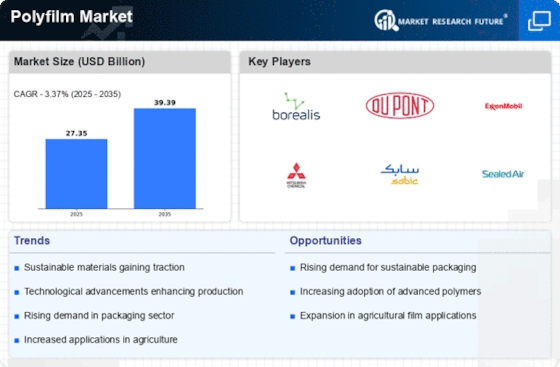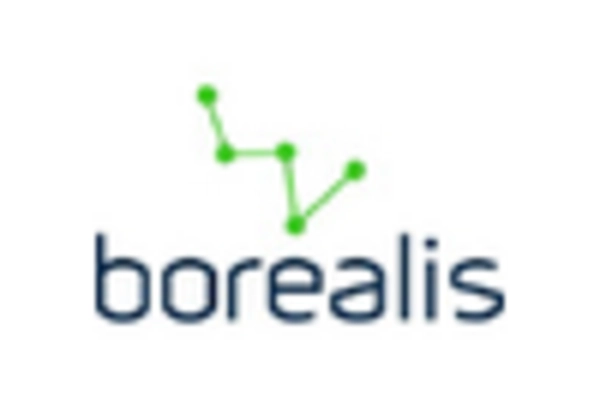Increased Focus on Sustainability
Sustainability initiatives are becoming increasingly pivotal within the Polyfilm Market. As consumers and regulatory bodies alike demand more environmentally friendly products, manufacturers are compelled to adapt their practices. The shift towards biodegradable and recyclable polyfilms is gaining traction, with many companies investing in research and development to create sustainable alternatives. Recent statistics indicate that the market for biodegradable films is expected to expand significantly, potentially reaching a valuation of several billion dollars by 2027. This emphasis on sustainability not only aligns with consumer preferences but also helps companies comply with stringent regulations aimed at reducing plastic waste. Consequently, the Polyfilm Market is likely to evolve, with a growing number of players prioritizing eco-friendly materials and production processes.
Growth in Agricultural Applications
The Polyfilm Market is witnessing a surge in demand for agricultural applications, particularly in the use of mulch films and greenhouse covers. These films play a crucial role in enhancing crop yield and protecting plants from adverse weather conditions. The increasing focus on food security and sustainable agricultural practices is driving the adoption of polyfilms in farming. Recent reports indicate that the agricultural film segment is projected to grow at a compound annual growth rate of around 6% over the next few years. This growth is attributed to the rising need for efficient farming techniques and the adoption of innovative agricultural practices. As a result, the Polyfilm Market is likely to expand, with manufacturers developing specialized films that cater to the specific needs of the agricultural sector.
Rising Demand for Flexible Packaging
The Polyfilm Market experiences a notable increase in demand for flexible packaging solutions. This trend is driven by the growing preference for lightweight and versatile packaging materials across various sectors, including food and beverage, pharmaceuticals, and consumer goods. Flexible packaging offers advantages such as reduced material usage, lower transportation costs, and enhanced product shelf life. According to recent data, the flexible packaging segment is projected to grow at a compound annual growth rate of approximately 4.5% over the next five years. This growth is indicative of a broader shift towards sustainable packaging solutions, as manufacturers seek to minimize their environmental footprint while meeting consumer expectations. As a result, the Polyfilm Market is likely to witness a surge in innovation and product development aimed at enhancing the performance and sustainability of flexible packaging options.
Expansion of E-commerce and Online Retail
The rise of e-commerce and online retail is significantly influencing the Polyfilm Market. As more consumers turn to online shopping, the demand for efficient and protective packaging solutions has surged. Polyfilms are increasingly utilized in the packaging of goods for shipping, providing durability and protection during transit. Recent data suggests that the e-commerce sector is expected to grow at a rate of over 15% annually, further driving the need for innovative packaging solutions. This trend presents opportunities for polyfilm manufacturers to develop specialized products that cater to the unique requirements of e-commerce packaging, such as lightweight, tear-resistant, and moisture-proof films. Consequently, the Polyfilm Market is likely to see a shift towards packaging solutions that enhance the customer experience while ensuring product integrity.
Technological Innovations in Film Production
Technological advancements are reshaping the Polyfilm Market, leading to enhanced production processes and product quality. Innovations such as advanced extrusion techniques, improved polymer formulations, and the integration of smart technologies are enabling manufacturers to produce high-performance polyfilms that meet diverse application needs. For instance, the introduction of nanotechnology in film production has resulted in films with superior barrier properties, extending product shelf life and reducing spoilage. Furthermore, automation and digitalization in manufacturing processes are streamlining operations, reducing costs, and increasing efficiency. As a result, the Polyfilm Market is poised for growth, with companies that leverage these technological advancements likely to gain a competitive edge in an increasingly crowded marketplace.

















Leave a Comment